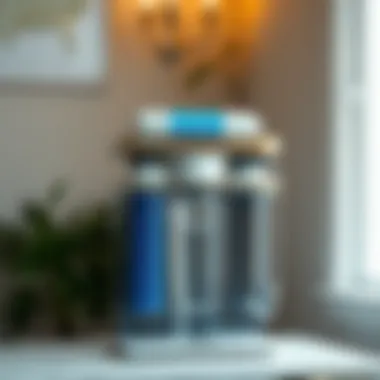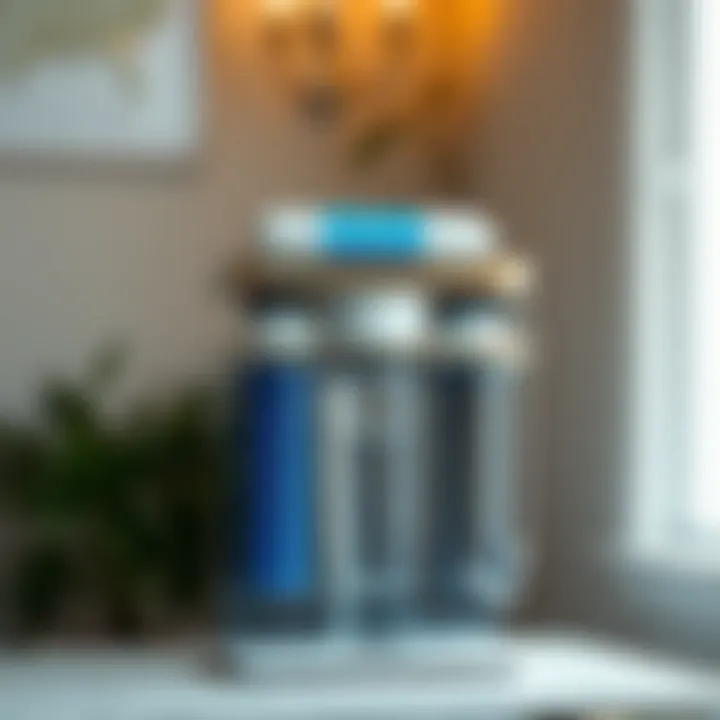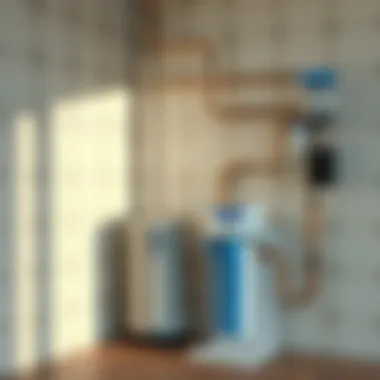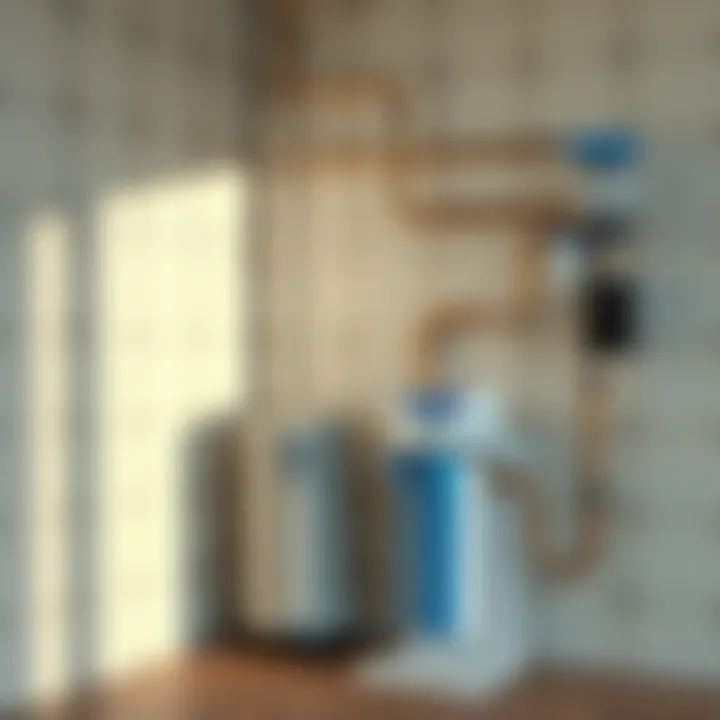In-Depth Review of the Waterdrop RO Filtration System


Intro
The importance of clean, safe drinking water can't be overstated. As households become increasingly aware of the role of quality water in wellness and health, water filtration systems are gaining traction in our daily lives. One noteworthy system making waves is the Waterdrop reverse osmosis water filtration system. This piece not only filters out impurities, but it also brings forth a unique combination of efficiency, style, and maintenance simplicity.
In this in-depth analysis, we will traverse the various facets of this system, examining its technology, installation process, advantages, and even how it harmonizes with different home aesthetics. From cost analysis to tips for keeping your system running smoothly, we’ll provide a detailed view that caters to both the practical housewife and the discerning homeowner. With the added benefits of promoting wellness in kitchen and bath areas, the Waterdrop system stands as a solid choice in modern water filtration. Let’s dive into the details.
Prolusion to Water Filtration Technology
In today's world, where accessibility to clean water is often taken for granted, understanding the underpinnings of water filtration technology has become essential. Clean water is not just a luxury—it's a fundamental necessity for maintaining health and well-being. The implications of consuming contaminated water can be dire, as various pollutants can lead to serious health issues. Consequently, investing in effective water filtration systems, such as the Waterdrop Reverse Osmosis Water Filtration System, becomes integral for households aiming to ensure their families are protected.
Importance of Clean Water
Having access to clean water plays a crucial role in overall health, particularly for families and young children. Contaminants, whether they be heavy metals, bacteria, or chemicals, often lurk in our tap water, potentially jeopardizing our health.
- Health Risks: Unfiltered water can harbor pathogens that lead to gastrointestinal diseases, among other serious conditions.
- Taste and Odor: Poor quality water often carries an unpleasant taste and smell, discouraging people from adequate hydration.
- Overall Wellness: Clean water contributes to better digestion, skin health, and maximum organ function, making it foundational to wellness.
"The best way to save your health is to keep your water clean."
In short, clean water is not merely a convenience; it's an indispensable component of a healthy lifestyle.
Overview of Filtration Methods
Water filtration encompasses various methods, each offering unique mechanisms for purifying water. Understanding these methods gives homeowners the ability to make informed choices regarding their water purification needs.
- Activated Carbon Filters: Common in pitcher and faucet systems, activated carbon is adept at absorbing chlorine, sediment, and volatile organic compounds, providing a basic level of water purification.
- Reverse Osmosis: This method employs a semipermeable membrane to remove contaminants by applying pressure, pushing water through the membrane while leaving impurities behind. This is the principle behind the Waterdrop system.
- Ultraviolet Purification: Using UV light, this method kills bacteria and viruses in the water. However, it doesn't remove particulates or chemical pollutants.
- Distillation: This process involves boiling water and then condensing the steam to eliminate contaminants. While effective, it is energy-intensive and can be slow.
- Pros: Affordable and easy to replace.
- Cons: Requires regular maintenance to ensure effectiveness.
- Pros: Effective at reducing a broad spectrum of contaminants, including heavy metals and bacteria.
- Cons: Potentially slower filtration rate and higher initial investment.
This comprehensive approach to different filtration methods highlights the choices available and their corresponding benefits, steering consumers towards the most appropriate option for their needs. Especially when considering systems like the Waterdrop Reverse Osmosis, which offers cutting-edge efficiency and effectiveness in water filtration.
The Mechanics of Reverse Osmosis
Understanding the mechanics of reverse osmosis is crucial for grasping how the Waterdrop filtration system operates. This technology doesn’t just fancy up a kitchen; it fundamentally alters the quality of water we consume each day. By comprehending the elements that drive reverse osmosis, homeowners can appreciate why it’s becoming a household staple. The benefits are significant, but so are the considerations that come with installing such a system. Not only does it aim for cleaner water, but it also appears to our modern sensibilities regarding sustainability and efficiency in water usage.
Principles of Osmosis
At the heart of the reverse osmosis system lies the principle of osmosis itself. At its core, osmosis is the movement of water across a semi-permeable membrane from an area of low solute concentration to one with a high solute concentration. Imagine a crowded street where people are trying to cross to the other side; they will naturally move to where there’s less congestion. Similarly, water molecules move through the membrane to balance out solute concentrations on both sides.
In the context of water filtration, this process ensures that clean, purified water is on one side of the membrane while contaminants and unwanted minerals are left behind. To counteract this natural flow, a pressure is applied, which essentially reverses the standard osmosis process, resulting in reverse osmosis. This technique allows for the removal of dissolved impurities that may otherwise infiltrate our drinking water, elevating its quality significantly.
The Role of Membranes
The membranes in a reverse osmosis system are often described as the unsung heroes of this technology. These are not just any filters; their craftiness lies in their ability to filter contaminants much smaller than even regular microscopic particles. Composed of thin layers of polymer-based material, these membranes selectively allow water molecules to pass while blocking ions, organics, and even bacteria.
"Membranes are the gateway to pure water, acting as a sophisticated sieve that ensures only the essential elements find their way into your glass."
It's important to note that not all membranes are created equal. The efficiency and longevity of a reverse osmosis system can hinge on the quality of its membrane. Homeowners need to be aware that over time, these membranes can clog or degrade, which calls for regular maintenance to ensure continuous performance. When choosing a system, look for membranes that boast a high rejection rate for contaminants, as well as durability to withstand various water conditions.
Investing in a water filtration system that effectively employs these principles not only serves functionality but also resonates with a growing concern for healthier living environments.
Key Features of the Waterdrop System
The Waterdrop reverse osmosis water filtration system isn’t just a piece of equipment; it’s thoughtfully designed to elevate your water quality and, by extension, your health. Understanding the key features of this system provides insight into its efficiency and effectiveness. Each feature plays a part in ensuring that you have clean, great-tasting water at your fingertips. Let's delve into what makes the Waterdrop system stand out.
Compact Design
One of the most striking aspects of the Waterdrop system is its compact design. In today's homes, space is at a premium, and bulky water filtration systems can be an eyesore as well as a hindrance. Waterdrop has cleverly engineered its units to not only fit under sinks but also to blend seamlessly into your kitchen's aesthetics. This space-saving design means it occupies minimal potential storage area yet delivers maximum performance. Imagine having a top-tier filtration system that doesn't force you to sacrifice style for functionality.
This means you can free up your countertop or cabinet space while still enjoying the benefits of purified water. The dimensions are such that it fits snugly, allowing easy access and maintenance. A huge plus for busy homeowners!
High Filtration Capacity
When it comes to filtration capacity, the Waterdrop reverse osmosis system truly shines. Its advanced multi-stage filtration process is designed to remove contaminants like chlorine, lead, and fluoride efficiently - delivered through a system capable of filtering a high volume of water quickly. This means fewer trips to refill pitchers and no more waiting around for water to be ready.
"With the ability to produce up to 400 gallons of purified water annually, this system is suitable for families who rely heavily on clean drinking water daily."


This high filtration capacity means not only can it handle the demands of larger households, but it also reduces the frequency of filter replacements, thus leading to cost savings over time. When you do the math, a system that operates efficiently and reduces waste is a win-win.
User-Friendly Interface
Navigating complex water filtration systems can feel like rocket science. However, the Waterdrop system comes equipped with a user-friendly interface that welcomes even the most technologically challenged among us. Its straightforward design ensures that you can easily monitor filter status and performance without the frustration often associated with maintaining such systems. Whether you're a tech whiz or not, this system is a breeze to interact with.
The interface often includes indicators that alert you when filters are nearing the end of their lifespan. You won’t have to guess the state of your system or risk drinking subpar water. A little push on a button or a glance at an app, and you're all set!
In summary, the Waterdrop reverse osmosis system not only delivers on performance but does so in a way that is accessible and attractive. These features make it a stand-out option for those looking to enhance their home with superior water filtration. Efficient, stylish, and easy to operate—just what busy homeowners need.
Health Benefits of Water Filtration
The significance of water filtration cannot be overstated, particularly in the context of enhancing the well-being of our households. With increasing contamination of water sources, filtering has become essential for safeguarding health. The Waterdrop reverse osmosis system plays a pivotal role in this effort, providing benefits that extend beyond merely quenching thirst. Understanding these advantages can empower homeowners, particularly housewives responsible for family health, to make informed decisions.
Removal of Contaminants
One of the primary health benefits of the Waterdrop system lies in its ability to remove a wide range of harmful contaminants from water. This filtration technology is effective at eradicating impurities such as chlorine, lead, pesticides, and other harmful chemicals that can lurk in tap water.
When one considers the potential health risks associated with these substances, the importance of filtration becomes glaringly evident. For instance, lead exposure, a problem all too common in older plumbing systems, can lead to severe cognitive and developmental issues, especially in children. By integrating reverse osmosis, homeowners can significantly reduce these risks.
Moreover, filtering out chlorine, often used in municipal water systems, can help prevent the formation of byproducts that may have adverse health effects.
The efficacy of the Waterdrop system in removing these contaminants has been validated through several tests and studies, making it a trustworthy choice for concerned households. With this system in place, you not only ensure cleaner drinking water but also contribute to a healthier environment for your family.
"Clean water is the cornerstone of good health for any family. By investing in a reliable filtration system, you are ensuring that your loved ones have the best, day in and day out."
Improvement of Taste and Odor
Equally important is how the Waterdrop system enhances the taste and odor of water. Water that tastes metallic or smells like bleach can deter even the most health-conscious individuals from staying properly hydrated. With reverse osmosis filtering out distance tastes and unpleasant odors, it transforms tap water into a refreshing source of hydration.
The blend of minerals and contaminants can produce an experience that is far from appealing. Many householders have noted a remarkable improvement in their drinking experience after installing the Waterdrop system. Not only does it make water more palatable, but it also encourages family members, especially children, to drink more—thereby contributing to their overall health.
Homeowners may find themselves saving money on flavored waters and drinks, as the purified water becomes far more enjoyable on its own. Additionally, this filtration technology allows for a more comforting experience in cooking, where the quality of water can indeed impact the flavors of dishes.
In summary, the health benefits of water filtration—specifically through the Waterdrop reverse osmosis system—extend beyond the fundamental need for hydration. From removing harmful contaminants to enhancing the overall drinking experience, this system stands out as a crucial asset for any household seeking to prioritize wellness.
Installation Guidelines
When it comes to the Waterdrop reverse osmosis water filtration system, the importance of installation cannot be overstated. A proper setup guarantees that you will get the most out of your investment in clean, delicious water. Many people might overlook installation, thinking it's just a technicality. However, it sets the stage for everything that follows—efficiency, safety, and, ultimately, satisfaction with the product. A clean installation leads to optimal performance and longevity of the system. On top of that, the ease of installation empowers homeowners to take charge of their water needs, enhancing both security and peace of mind.
Preparing Your Space
Before you can roll up your sleeves and dive into the installation, preparing your space is a crucial step that often flies under the radar. Ensuring that the area where you’ll be installing the Waterdrop system is clean and functional can make or break the experience.
Start by identifying a suitable location. Typically, under the kitchen sink is the preferred spot due to ease of access to water connections. Make sure the area is free from dirt and clutter; a clean workspace reduces the chances of parts getting misplaced or damaged.
Here are some considerations for preparing:
- Accessibility: Ensure you can easily reach the faucet and water supply lines.
- Space: Clear out any unnecessary items that could hinder the installation process.
- Tools Required: Gather tools such as a wrench, screwdriver, and bucket for any spills.
Taking the time to adequately prepare not only sets you up for a smoother installation but also enhances user experience in the long run by ensuring everything is within reach.
Step-by-Step Installation Process
Now that your space is primed for action, it’s time to get into the nitty-gritty of the installation process itself. Following a systematic approach will help you avoid common pitfalls. Below is a step-by-step guide to installing your Waterdrop reverse osmosis system:
- Turn Off the Water Supply: Safety first! Before anything else, shut off the water supply leading to your kitchen faucet.
- Connect the RO Membrane: Rinse the RO membrane and attach it securely to the filter housing.
- Install the Water Storage Tank: Place it in the prepared area, ensuring it’s stable. Connect it to the system following the instructions provided in the manual, avoiding leaks at all costs.
- Connect Filtration System to Water Supply Line: Generally, this involves attaching a T-valve. Make sure the line is secure to prevent any surprises later.
- Mount the Faucet: Drill a hole if necessary (if you’re adding a dedicated faucet). Connect the faucet to the system in a way that’s sturdy but allows for easy access.
- Flush the System: Follow the instructions in the manual to run water through the system for a couple of hours. This ensures that any impurities left from manufacturing are washed away.
Following these steps carefully can significantly enhance the efficiency and effectiveness of your Waterdrop filtration system. Each step builds upon the last, leading to an elegantly filtered water experience.
Tip: Always refer to the user manual specific to your model for any unique requirements and helpful diagrams.
Lastly, don’t rush through this process. Every little step you take toward a proper installation contributes to the overall performance and longevity of your water filtration system.
Resources to Consider
- For additional insights, you may refer to Water Quality Association for guidelines on installations.
- User experiences and advice can also be beneficial, so consider browsing discussions on reddit.com
With a solid installation, you’ll be set to enjoy the benefits of high-quality filtered water right from your tap!


Maintenance and Care
Proper maintenance and care for the Waterdrop reverse osmosis filtration system are crucial in ensuring optimal performance and longevity. Just like a well-tuned engine, when maintained correctly, this system can deliver fresh, clean water consistently. Ignoring upkeep can lead to decreased performance, unpleasant tastes, and even system failure, which is something no homeowner wants to deal with after investing in such a valuable appliance.
Regular Filter Replacement
One of the most integral parts of maintaining the Waterdrop system is the regular replacement of its filters. Over time, filters accumulate impurities, and their efficiency diminishes. Not replacing them on a timely basis can make your water not just less palatable but also less safe.
Typically, the filters in Waterdrop systems should be replaced every 6 to 12 months, depending on your water usage and the quality of the input water. For instance, if you're in an area where the water is particularly hard or contaminated, it may necessitate more frequent changes.
Benefits of Regular Replacement:
- Enhanced Water Quality: Fresh filters run at peak efficiency, significantly improving taste and clarity.
- Health and Safety Assurance: Regularly changing filters reduces the risk of contaminants slipping through
- System Efficiency: New filters help the entire system work effectively, preserving your investment in the long run.
To keep track, many users set reminders on their phones or calendars. Some even utilize the system's app, if available, to help monitor usage and inform them when it’s time to change filters.
Troubleshooting Common Issues
No system is without the occasional hiccup, and the Waterdrop filtration system is no exception. Being aware of common issues and knowing how to troubleshoot can mean the difference between a simple fix and a costly service call.
Common Problems and Solutions:
- Low Water Pressure: This might indicate a clogged filter or an issue with the water supply. Checking the filter for clogs can be the first step in resolving this.
- Unpleasant Taste or Odor: If the water has an odd taste or smell, it could suggest that the filters are exhausted or need replacement.
- Water Leaks: Inspect the connections and hoses if any leaking occurs. Sometimes, simply tightening fittings can resolve the issue.
- System Not Filling: This could be a result of a faulty valve or a blocked line. Checking the inlet for blockages can be a good starting point.
"A stitch in time saves nine." Addressing minor issues promptly helps prevent escalation into major problems.
Understanding when to call for professional help is also part of good maintenance. If troubleshooting doesn’t fix the issue, it’s best to consult the user manual or reach out to customer service. They often have additional insights tailored to your situation.
Cost Analysis
Understanding the cost implications of the Waterdrop reverse osmosis water filtration system is vital for potential buyers, particularly those who manage household budgets. The cost analysis covers not just the initial expenditure involved in acquiring the system, but also engages with the long-term savings that come with using the system over time.
Initial Investment
When it comes to the initial investment, the Waterdrop system may seem pricey when compared upfront to more traditional water filtration options. However, it’s crucial to look at this as a long-term investment in health and convenience. Starting from the point of choosing the right model, homeowners should consider the specifications — the filtration capacity, energy efficiency, and additional features.
Prices typically range from around $200 to $700, depending on features and capacity. The higher end of the price range often comes with advanced systems that reduce more contaminants.
Remember, installation kits might add to the cost, so budgeting for professional installation, if preferred, should also be taken into account. But many find that the ease of installation, coupled with user-friendly guides, means they can handle it themselves, ultimately saving more cash.
Key considerations for the initial investment include:
- Model features: Higher-capacity models, such as the Waterdrop G3, while more expensive, may offer better efficiency.
- Installation: Factor in whether you’ll DIY or hire a professional.
- Additional components: Extras like sediment filters or post-filters can add to the overall initial expenses.
Long-Term Savings on Bottled Water
Once the system is installed and operational, one of the most significant benefits emerges: the potential to save money on bottled water. Research indicates that a family might spend approximately $300 to $400 annually on bottled water. With the Waterdrop system, the expenses for purchasing bottled water can drastically diminish.
The average cost per gallon of the filtered water from the Waterdrop system can work out to be significantly lower than buying bottled.
Let’s break down the math:
- Cost of Bottled Water: Assuming you buy about 4 bottles per week at an average of $1 each, that’s about $200 per year. With larger purchases, this cost can skyrocket.
- With Waterdrop: Once the installed system is up and running, the cost of producing a gallon of water at home drops significantly. Homeowners can expect their water expenses to be a fraction of what bottled water typically costs.
Through careful calculations, users often find they recover the initial investment in just a year or two. Additionally, there’s the benefit of lifestyle change: managing plastic waste effectively while ensuring a steady supply of clean drinking water.
In summary, while the upfront cost may feel steep, the long-term benefits outweigh these concerns considerably. The Waterdrop reverse osmosis system offers not just clean water, but also an economic advantage—making it a smart choice for families aiming to reduce both spending and environmental footprint.
Environmental Considerations
The role of the Waterdrop reverse osmosis water filtration system transcends mere convenience. It becomes critical when we scrutinize its environmental impact and sustainable benefits. As households are increasingly burdened with managing waste and conserving resources, homeowners find themselves at the crossroads of cleanliness and sustainability. Investing in water filtration systems not only elevates the quality of hydration but also extends to eco-conscious living.
Reduction of Plastic Waste
In a world where single-use plastic has become synonymous with environmental degradation, the Waterdrop system offers an effective countermeasure. Each year, millions of tons of plastic bottles are discarded, often ending up in landfills and oceans, wreaking havoc on ecosystems. According to the Environmental Protection Agency, Americans recycled only about 8.7% of plastic waste in 2018. This statistic underscores the urgency of seeking alternatives.
Adopting a Waterdrop reverse osmosis unit at home can drastically reduce reliance on bottled water. Homeowners will find that they can enjoy pure, crisp water straight from their tap without the need for plastic packaging.
"Switching to an effective water filtration system like Waterdrop not only saves money but also demonstrates a commitment to reducing plastic waste effectively."


Conservatively projecting, an average family could save over 1,000 plastic bottles annually. This staggering figure highlights how much impact one household can have on reducing plastic pollution. Each gallon of filtered water represents a step towards a cleaner environment, urging families to contribute positively to the planet's health.
Sustainable Water Usage
Sustainable water usage is an essential pillar in addressing global water scarcity. The Waterdrop reverse osmosis system facilitates this endeavor. Reverse osmosis technology allows for efficient filtration processes without excessive water waste. Unlike traditional filtration methods that may require more water to cleanse a smaller amount, this system optimizes the filtration experience by turning faucet water into refreshing, drinkable water, minimizing waste during the process.
Maintaining a balance between domestic water consumption and sustainability becomes reconciled through such advanced technology. Homeowners become able to manage their water usage responsibly, ensuring that each drop counts in their daily hydration routines. Encouraging families to drink more water from their home reduces the pressure on local water resources while encouraging better hydration habits.
User Experiences and Reviews
User experiences and reviews play a crucial role in understanding the practical implications of any product, most notably in something as vital as water filtration systems. For many housewives and homeowners, not all water filters are created equal. Insights from other users provide a real-world touch to the marketing spiel, revealing both the strengths and shortcomings of the Waterdrop reverse osmosis system. This section dives into the lived experiences of users, giving importance to their feedback as a basis for making informed decisions.
Positive User Feedback
Many users have found the Waterdrop reverse osmosis water filtration system to be a game changer in their daily lives. For instance, a recurring theme in reviews is the immediate improvement in water taste. People have remarked that water from the system has a crisp and refreshing quality, absent of the chlorinated taste often associated with tap water. This is particularly important for those who have kids or are health-conscious. Clean, great-tasting water encourages families to drink more, promoting hydration and overall wellness.
Additionally, users often highlight the ease of installation and sleek design. Several homeowners mention being pleasantly surprised at how simple it was to set up the system by themselves, without the need for professional help. The compact design not only saves space under the sink but also fits seamlessly with modern kitchen aesthetics, keeping things looking tidy and organized.
Moreover, many reviewers appreciate the transparent filter change indicator that comes with the Waterdrop system. Knowing when to replace the filters helps ensure the water remains pure and free of contaminants, giving users peace of mind. According to one enthusiastic user, "It’s like having a personal water sommelier at home!" This loyal user even claimed that once they tried the system, they could never go back to bottled water.
Critical Perspectives
Despite the overwhelming positive feedback, it's also essential to consider critical perspectives. Some users have pointed out that the initial cost can be a turnoff. The investment needed for the Waterdrop system is higher compared to standard pitcher filters. This upfront expense might lead some to question whether the benefits justify the cost in the long run. A few homeowners indicated that the long-term savings on bottled water weren't enough to outweigh the initial outlay, particularly for families with tighter budgets.
Another concern raised has been related to pressure and output. While the system does provide good filtration, some users reported slower refill rates compared to their previous systems. They mentioned that if they needed water quickly for larger cooking tasks, it took longer than desired. Such experiences highlight that while the technology excels in purity, it might not suit every household's immediate needs.
Lastly, there’s the matter of maintenance; some users found regular filter replacements a little inconvenient. While the indicator does help, remembering to purchase and install new filters isn’t always a laid-back task. One user noted, "It’s great and all, but sometimes I wish it would just take care of itself!"
In summary, user experiences encapsulate a blend of enthusiastic approval mingled with constructive criticism. Whether it's a sparkling refreshment or a minor setback, these narratives underscore the diversity in household needs and personal preferences when it comes to the Waterdrop reverse osmosis water filtration system.
Comparison with Other Filtration Systems
In today's world, access to clean water is not just a luxury; it's a necessity. Homeowners often find themselves faced with a multitude of options when it comes to water filtration systems. This section will delve into the comparison of the Waterdrop reverse osmosis (RO) system with other common filtration methods, highlighting the key differences and the unique advantages that Waterdrop brings to the table. Understanding these distinctions is crucial for making an informed decision about maintaining optimal water quality in your home.
Waterdrop vs. Traditional Filters
Traditional filters, such as activated carbon units, serve a specific purpose: they remove chlorine and some sediment but tend to leave most dissolved solids unattended. For a homeowner looking for comprehensive purification, this can be a bit like sweeping dirt under the rug — it may look clean, but the underlying problems remain.
Waterdrop's reverse osmosis system, on the other hand, offers a more thorough solution. It not only tackles chlorine but also filters out harmful substances like lead, arsenic, and other dissolved solids. To provide clarity, consider the following points:
- Filtration Efficiency: Waterdrop’s multi-stage filtration process involves several stages, including sediment and activated carbon filters followed by the RO membrane. Traditional filters simply don't have the same thoroughness.
- Water Quality: Users often report that water from the Waterdrop system tastes noticeably fresher and cleaner compared to traditional methods, which can leave a chemical aftertaste.
- Maintenance: Traditional filters generally require frequent replacement. The Waterdrop system minimizes hassle by offering longer intervals between necessary maintenance tasks, making it a more convenient option.
"You don't just want clear water, you want water that's safe and delicious. Imagine sipping straight from the stream — that's what Waterdrop aims to achieve."
This perspective shows why more individuals are seeking to upgrade from traditional filtering setups to advanced systems like Waterdrop.
Waterdrop vs. Pitcher Filters
Pitcher filters are a popular choice for many due to their low upfront cost and simplicity. However, they have limitations that can make them less appealing for a household looking for serious water purification.
Here’s how Waterdrop stacks up against these convenient little pitchers:
- Filtration Speed: Pitchers can be slow, needing time to filter when filled. Waterdrop provides filtered water on demand, meaning no waiting around.
- Filter Lifespan: The filters in pitcher systems usually have to be replaced every few weeks. In contrast, Waterdrop filters can last several months before they need changing, reducing both cost and waste in the long run.
- Health Considerations: While pitcher filters may reduce some contaminants, they can’t match the comprehensive filtration capability of Waterdrop’s system. For instance, while a pitcher may reduce chlorine taste, it will not necessarily eliminate other harmful things, which is where health concerns come into play.
- Convenience: The integrated features of the Waterdrop installation, such as the ease of connecting to plumbing, offers a more seamless experience. No need for constant refilling that comes with pitchers.
Overall, while pitcher filters might seem like an easy solution at first glance, they can fall short when it comes to efficacy and longevity compared to a system like Waterdrop. It's about investing in your health and well-being in the long haul.
Epilogue and Recommendations
The exploration into the Waterdrop reverse osmosis water filtration system highlights the vital role of water purification in our everyday lives. Clean, safe drinking water is not just a luxury; it's a necessity. As the world increasingly turns its gaze toward sustainable living, understanding and implementing effective water filtration solutions becomes paramount. The Waterdrop system stands out due to its innovative features, such as efficiency and user-friendliness, making it an appealing option for homeowners seeking to improve their water quality while maintaining a compact design.
Summary of Key Points
In summary, several critical aspects underscore the importance and effectiveness of the Waterdrop system:
- Advanced Technology: Utilizing reverse osmosis ensures a high level of purification, effectively removing contaminants that can affect both health and taste.
- Ease of Installation: The step-by-step installation guide simplifies the process, allowing homeowners to efficiently set up their filtration system without requiring professional help.
- Maintenance: Regular filter replacement is straightforward, ensuring consistent water quality without excessive hassle.
- Cost-Effectiveness: Over time, the reduction in dependency on bottled water can lead to significant savings, making the initial investment worthwhile.
- Environmental Impact: By reducing plastic waste, the Waterdrop system plays a role in supporting a more sustainable lifestyle.
These points not only highlight the system's superior features but also emphasize its overall value for health, economic savings, and the environment.
Final Thoughts on Implementation
When it comes to implementation, there are a few considerations that can aid homeowners in making the most of their investment in the Waterdrop filter:
- Assess Your Home's Water Quality: Before installation, it's advisable to conduct a water quality test to understand the specific contaminants present. This insight can guide your filtration needs.
- Follow Maintenance Protocols: Adhere strictly to the manufacturer's recommendations for filter replacements and routine checks. It's crucial in ensuring that the system operates at peak performance.
- Incorporate into Kitchen Design: Consider how the Waterdrop system fits into your kitchen aesthetics. Its compact nature allows for seamless integration, which can elevate the overall ambiance of the space.
- Educate Family Members: Ensure that everyone in the household understands the benefits of the system, including how to use it properly. This not only enhances appreciation for clean water but also fosters responsible usage.
Ultimately, the journey toward cleaner water begins with informed choices. By choosing the Waterdrop reverse osmosis filtration system, homeowners are not only investing in their health but are also taking steps towards a sustainable future. With the easy installation and maintenance process, it becomes a hassle-free addition to any home.















